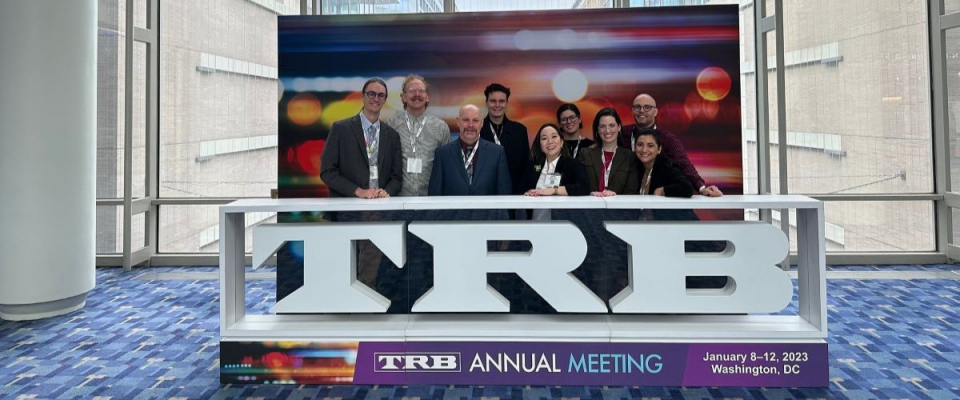The NITC Guide to the 2024 Transportation Research Board (TRB) Annual Meeting

The 103rd annual meeting of the Transportation Research Board (TRB) will be held January 7–11, 2024 in Washington, D.C., and NITC transportation faculty and researchers will be sharing their expertise at the world's largest transportation conference. The TRB annual meeting attracts thousands of transportation professionals from around the globe to address transportation policy, practice, and plans for the future.
Below are a few highlights of research being presented by transportation experts from our participating NITC-funded campuses: Portland State University (PSU), University of Oregon (UO), University of Utah (UU), University of Arizona (UA), and University of Texas at Arlington (UTA). Check out our full NITC guide for all of the sessions:
VIEW THE ONLINE GUIDE TO NITC AT TRB 2024
*Due to the evolving status of speaker attendance and TRB programming, please check your TRB schedule for the most current information in the event of changes.*
NITC Research Highlights at TRB 2024
University of Texas at Arlington
Monday, January 8 - Older Adults, Travel Options, and Barriers to Accessibility
In this lectern session, Juana Perez, Mohammad Rashidi, Jobaidul Boni and Kate Hyun of the University of Texas, Arlington, will present with Bahareh Farrokhi Seri Park of University of Nevada, Reno on "Older Adults’ Perceptions and Behaviors on Driving: A Mixed Method Study."
Understanding older adults' driving behavior based on their personal assessment, along with challenges they encounter when driving will support community leaders and policymakers to develop effective supportive strategies for their safety on the road. This study uses a mixed methodology approach including a survey and an interview to examine older drivers' perceptions and concerns regarding their driving habits. The researchers determine that participants’ concern regarding roadway infrastructure elements and driver behavior can be resolved through improvements in road design and driver education.
In addition to surveying 146 low-income older adults, researchers conducted in-depth phone interviews with 18 respondents to learn more about their daily activities specifically during the COVID-19 pandemic. The research team found that both drivers and non-driver older adults reduced their trip frequency and depended on family and friends for essential needs. In particular during the pandemic lockdowns, older adults developed their fear of using public transit and paratransit because they were concerned about other passengers not maintaining social distance. One of the noticeable differences is that more older adults started to use ride-hailing services and some even preferred it to public transit.
Two themes emerged when talking about the pandemic: (1) sedentary behaviors, and (2) the negative impact on mental health and social well-being. Many participants said restrictions against congregating, gatherings, and group exercise at senior centers affected their overall physical health. Learn more about the NITC project: Developing Strategies To Enhance Mobility And Accessibility For Community-Dwelling Older Adults.
University of Utah
Monday, January 8 - Innovation in Accessible Transportation and Mobility
In this poster session, Zihao Wen, Xiaoyue Liu and Andy Hong of the University of Utah will present "Measuring Accessibility for Older Adults based on an Adjusted Two-step Floating Catchment Area Method."
Accessibility is an important indicator to evaluate the shortage of essential services for older adults. However, the lack of relevant studies has hampered the research on comprehensively understanding the real travel experience of this special group of population. To fill this gap, this study proposed an accessibility measure model for older adults. The developed methodological framework is highly generalizable and can be extended to other regions for evaluating and analyzing older adults’ mobility and access equity of resources.
To examine the travel behavior of older adults, the researchers distributed a survey and conducted a focus group. They reached 724 older adults with the survey, in which participants were asked to rank their four most preferred activities and answer questions regarding transportation to and from those activities. Using those responses, the researchers measured the older adults’ travel behaviors and travel satisfaction. Overall, the researchers found significant dissatisfaction and vulnerability in older adults with limited mobility. Learn more about the NITC project: Transportation for Seniors (T4S): Developing a New Accessibility Measure to Support Older Adults in a Post-Pandemic World.
University of Arizona
Monday, January 8 - Current Issues in Economic Development and Land Use
In this poster session, Arthur C. Nelson, Robert Hibberd and Kristina Currans of the University of Arizona will present "Using the Real Estate Market to Evaluate Transit Station Proximity Outcomes with Implications for Post-Pandemic Transit and Land Use Planning."
Results from the United States’ largest cross-section study into how office and multifamily real estate rents vary with respect to transit station proximity in 2019, the year before the COVID-19 pandemic. The relationship between transit station proximity and office and multifamily rents is evaluated for light rail transit, bus rapid transit, and streetcar transit systems. For about half the transit systems studied, office rents do not respond positively to station proximity but instead have negative or ambiguous associations. In contrast, about three-quarters of the transit systems have favorable market associations with respect to multifamily rents. This analysis can be viewed as the pre-COVID-19 pandemic benchmark for all future research into the association between office and multifamily rent with respect to transit station proximity. Learn more about the NITC project: Transit Impacts on Jobs, People and Real Estate.
"The poster presents our cross-section analysis into how office and multifamily real estate rents vary with respect to transit station proximity in 2019, the year before the COVID-19 pandemic. The relationship between transit station proximity and office and multifamily rents is evaluated for light rail transit, bus rapid transit, and streetcar transit systems. For about half the transit systems studied, office rents do not respond positively to station proximity but instead have negative or ambiguous associations. In contrast, about three-quarters of the transit systems have favorable market associations with respect to multifamily rents. Multifamily real estate is positioned to outbid office real estate near transit stations in a post-pandemic world," said lead researcher Arthur C. Nelson.
Portland State University
Sunday, January 7 - Bicycle and Pedestrian Data Fusion: Learning from Each Other
In this workshop, Sirisha Kothuri of Portland State University will present "Exploring Data Fusion Techniques to Estimate Network-Wide Bicycle Volumes."
Traditional bicycle counters can provide data for limited sections of the bike network, often these counters are installed at important locations like trails or bridges. While limited in location, they count everyone who bikes by. Meanwhile, GPS & mobile data cover the entire transportation network, but that data only represents those travelers who are using smartphones or GPS. Combining the traditional location-based data sources with this new, crowdsourced data offers better accuracy than any could provide alone. This project drew data from Location Based Services (LBS), app, and bike share, as well as more traditional infrastructure and socio-demographic datasets. The outcome of this research could help transportation agencies get a better handle on how many people are biking in their communities.
"At ODOT we just adopted "Bicycle Miles Traveled" as a new key performance measure, and we need a way to measure it, so this project very much helps to fill the gap on how we're going to do that. This research used cutting-edge data fusion techniques that could lay the groundwork for how transportation agencies like ODOT monitor bicycle activity across the system," said Josh Roll, Research Analyst & Data Scientist at the Oregon Department of Transportation. Learn more about the NITC project.
Student Highlights
NITC Student of the Year
We're proud to announce our 2023 Outstanding Student of the Year, Justin Delgado of the University of Utah.
Justin Delgado is a master’s student in the City and Metropolitan Planning Department at the University of Utah. He has been selected as the 2023 NITC Student of the Year and will be presented with the award at the Council of University Transportation Centers banquet at the annual meeting of the Transportation Research Board in January 2023. Justin’s interest in transportation began through his negative personal experiences as a pedestrian and cyclist. His recognition of the inequitable distribution of safe infrastructure between mobility types led him to advocate for the right to travel safely for all types of mobility. Justin currently works as a dual Graduate Assistant for the Physical Enterprise Planning and Development Office (formerly PDC) and the Active Transportation branch of the Sustainability Office at the University of Utah. Justin also actively serves as president of the Urbanists at the University of Utah, Utah’s only nationally recognized planning student group. Read more about Justin.This award is presented during the Council of University Transportation Centers (CUTC) banquet at each annual meeting of the Transportation Research Board, where the U.S. Department of Transportation honors an outstanding graduate student from each UTC. Justin Delgado will be presented with the award for NITC at this year's CUTC award ceremony.
11 NITC Students Awarded Eisenhower Fellowships
Eleven students attending partner universities of the National Institute for Transportation and Communities (NITC) are receiving Eisenhower Fellowships presented by the U.S. Department of Transportation at this year's annual meeting. We are very proud of these outstanding students! Meet the NITC Eisenhower Fellows.
Photo courtesy of Cameron Bennett
The National Institute for Transportation and Communities (NITC) is one of seven U.S. Department of Transportation national university transportation centers. NITC is a program of the Transportation Research and Education Center (TREC) at Portland State University. This PSU-led research partnership also includes the Oregon Institute of Technology, University of Arizona, University of Oregon, University of Texas at Arlington and University of Utah. We pursue our theme — improving mobility of people and goods to build strong communities — through research, education and technology transfer.

